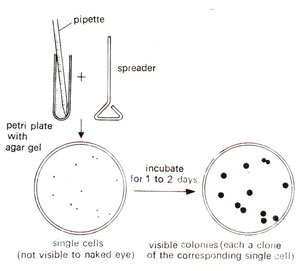Most of the important work on genetics of bacteria was atleast initially done on colon bacillus
(Escherichia coli = E. coli). These bacteria can be grown in petri-dishes or in culture tubes on a simple culture medium consisting of glucose, ammonium salts and a few additional substances needed in traces. From these simple substances, other complicated substances like vitamins and amino acids can be manufactured by the bacteria themselves. The strains of bacteria which can grow on this simplest medium, are called
prototrophs. However, certain mutant strain may be incapable of manufacturing a particular substance, so that this specific substance will have to be added to the simplest (minimal) medium for the growth of the mutant strain. Such a mutant strain is called an
auxotroph. While a prototroph can grow on the minimal medium, the auxotrophs will always grow on supplemented media.

Fig. 12.2. Technique of growing single cell bacterial colonies in the laboratory (spreader is used to spread a drop of suspension culture, on agar plate, giving single cells by repeated spreading).
There may be available mutants of other kinds as well. For instance a strain may be a mutant in regard to its capacity to resist infection by a virus or it may be resistant to an antibiotic like streptomycin. These resistant strains are though mutants, can still grow on minimal medium and will therefore be called prototrophs and not auxotrophs. Auxotrophs are only those mutants which are deficient only in their nutritional requirements.
Bacteria can be grown either in liquid medium or on the surface of medium which is made solid by means of agar (a gelatin like substance). In liquid medium, cells will always remain scattered, but on a solid medium, the products of cell division will remain together to form a colony, so that ultimately each colony will represent descendants of a single cell (Fig. 12.2). Availability of these culture techniques enable detection of a few prototrophs among millions of cells. If millions of auxotrophic cells containing a few prototrophs are placed on an agar plate with minimal medium, only the prototrophs will grow, so that if the number of cells plated is known, the relative proportion of prototrophs can be easily worked out.

Fig. 12.2. Technique of growing single cell bacterial colonies in the laboratory (spreader is used to spread a drop of suspension culture, on agar plate, giving single cells by repeated spreading).





